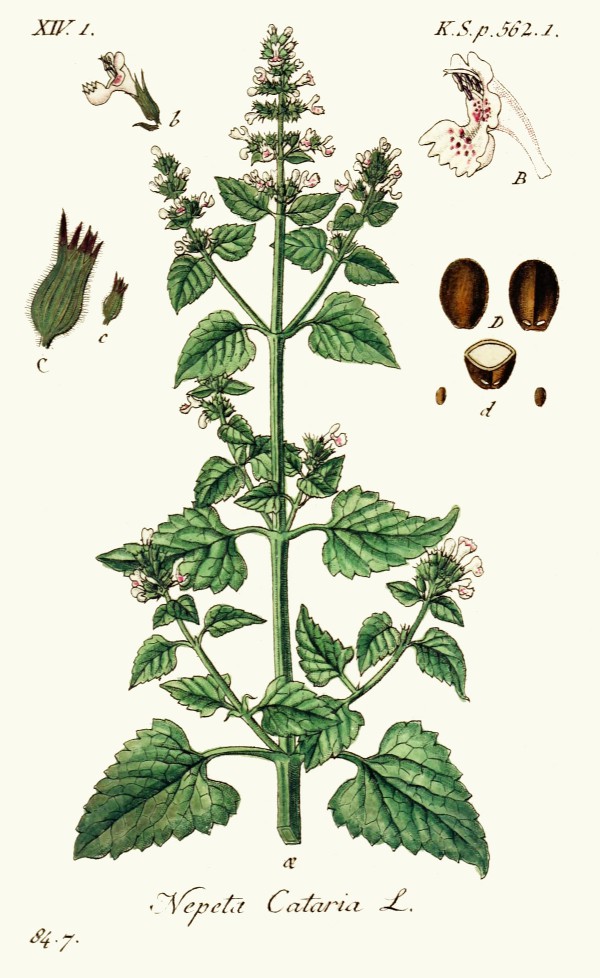Nepeta cataria L. - Lamiaceae - catnip, catmint, (Echte) Katzenminze
Perennial herb, up to 150cm tall, native to the eastern Mediterranean region, southern and central Asia, naturalized in Central Europe, cultivated in gardens as ornamental and attractand for cats; leaves ovate to triangular-cordate, crenate to dentate, pubescent; flowers white with purple spots on lower lip, white villous, throat pubescent inside.
http://www.efloras.org/florataxon.aspx?flora_id=2&taxon_id=200019873
„Catnip contains the feline attractant nepetalactone. Nepeta cataria (and some other species within the genus Nepeta) are known for their behavioral effects on the cat family, not only on domestic cats but also other species of cats. One test showed that tigers, leopards, and lynxes all reacted strongly to catnip in a manner similar to domestic cats, while lions reacted less frequently.“
http://en.wikipedia.org/wiki/Nepeta_cataria
Caryophyllene (18%), Z,E-nepetalactone (36%), and E,Z-nepetalactone (45%) were the main components of catnip oil. E,Z-nepetalactone and Z,E-nepetalactone demonstrated high repellency against mosquitoes.
„The skin test for evaluating the repellency of the two major active ingredients of the catnip oil, Z,E-nepetalactone and E,Z-nepetalactone, showed that a blend containing the 2 compounds at a 3:1 ratio has the highest and longest repellent activity.“
[Adult repellency and larvicidal activity of five plant essential oils against mosquitoes., Zhu, J., Zeng, X., Liu, T., Qian, K., Han, Y., Xue, S., Zhang, A., Journal of the American Mosquito Control Association, 22(3), 2006, 515-522] http://lib.dr.iastate.edu/cgi/viewcontent.cgi?article=1314&context=ent_pubs
Catnip essential oil acts as a repellant to flies [Efficacy and safety of catnip (Nepeta cataria) as a novel filth fly repellent. Zhu JJ, Zeng XP, Berkebile D, DU HJ, Tong Y, Qian K. Med Vet Entomol. 2009 Sep;23(3):209-16] as well as mosquitoes [Repellent activity of catmint, Nepeta cataria, and iridoid nepetalactone isomers against Afro-tropical mosquitoes, ixodid ticks and red poultry mites. Michael A. Birkett, Ahmed Hassanali, Solveig Hoglund, Jan Pettersson, John A.Pickett, Phytochemistry Volume 72, Issue 1, January 2011, Pages 109–114]
http://aceci.org/documents/Repellent_activity_of_Catmint_against_Afro-Tropical_Mosquitoes_2011.pdf
Major constituents of the essential oil are the nepetalcatones (85-90%) with 4a-α,7-α,7a-β-nepetalactone (55-58%) and 4a-α,7-β,7a-α-nepetalactone (30-31%). Other constituents are α-pinene, β-pinene, trans-caryophyllene and caryophyllene oxide, 1-cyclohexen-1-yl-methyl ketone, α-Humulene, 11-dodecenol, spathulenol and thymol.
[Chemical Composition and Antimicrobial Activities of Essential Oils from Nepeta cataria L. against Common Causes of Food-Borne Infections. Kamiar Zomorodian, Mohammad Jamal Saharkhiz, Samaneh Shariati, Keyvan Pakshir, Mohammad Javad Rahimi, and Reza Khashei. ISRN Pharmaceutics Volume 2012 (2012), Article ID 591953]
http://www.hindawi.com/journals/isrn.pharmaceutics/2012/591953/
Lemon catnip essential oil:
„The essential oil of the herb Nepeta cataria L. var. citriodora … main constituents of all the samples studied were the monoterpene alcohols (R)-(+)-β-citronellol and geraniol. The largest amounts of monoterpene aldehydes (geranial and neral) were found in the hydrodistilled oil. α-Amyrin (a precursor of ursolic acid) was also detected in the oil. trans-Rose oxide, α-terpineol, geranic acid, and trace amount of rose-oxide were found in the steam distilled oil only.
[GC–MS Analysis of Lemon Catnip (Nepeta cataria L. var. citriodora Balbis) Essential Oil. A Wesołowska, D Jadczak, And M Grzeszczuk. Journal of The American Society for Mass Spectrometry - J AMER SOC MASS SPECTROM. 01/2001; 12(12):1348-1351]

Sturm, J., Sturm, J.W., Deutschlands flora, vol.19 t.84.7 (1843)
http://plantgenera.org/species.php?id_species=697393
Nepeta cataria; author: Rolf Marschner (2005),
www.botanische-spaziergaenge.at
